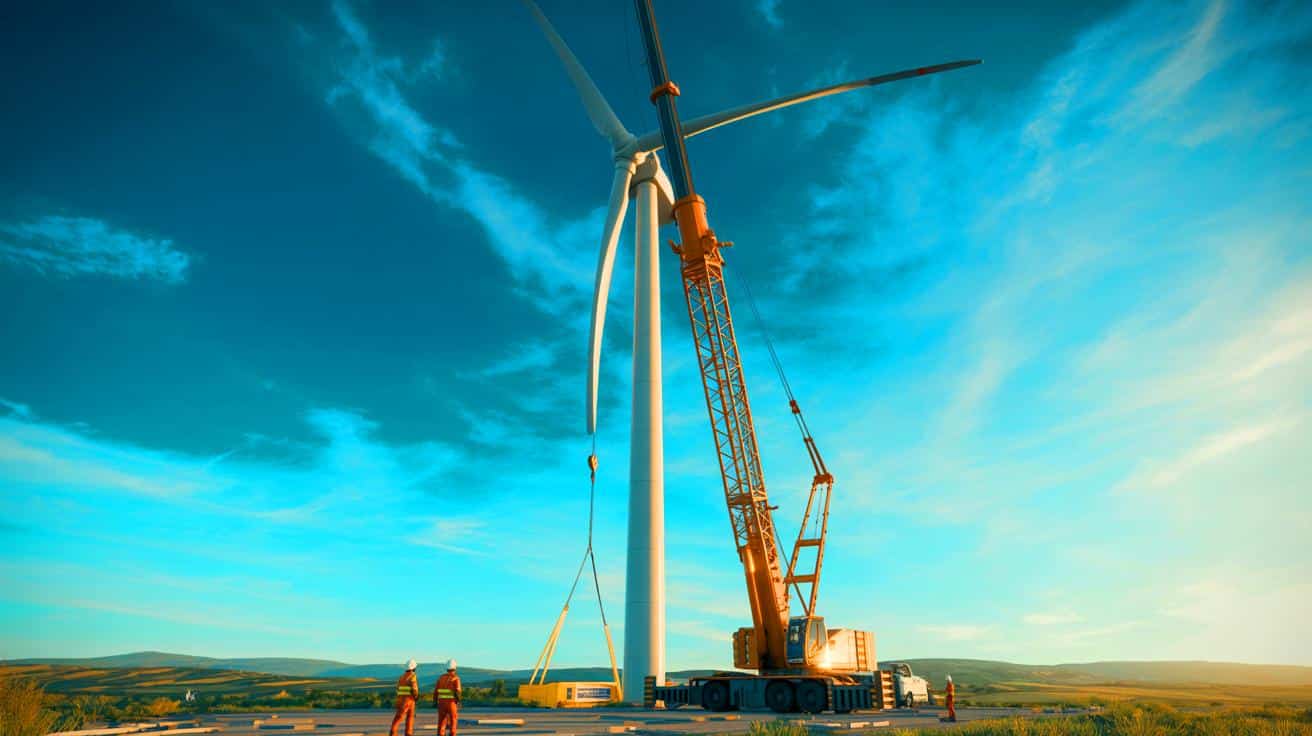- 🔧 The upcoming “crane day” is a crucial milestone for Pecos Wind Power and its innovative turbine.
- 🌬️ The turbine features a 100-foot diameter and 14.5-meter blades, promising enhanced performance.
- 💡 Federal funding through the Competitiveness Improvement Project supports this breakthrough in wind energy.
- 📈 The project aims to make wind energy more accessible and affordable in rural communities.
Amidst the rapidly evolving landscape of energy solutions in the United States, a significant milestone is on the horizon: “crane day” for wind power. This event marks the assembly of a new type of wind turbine that promises to redefine distributed wind systems. Developed by Pecos Wind Power, this turbine is notable for its 100-foot diameter and 14.5-meter blades. Though still in its developmental phase, the project signifies a shift towards enhanced performance and innovative design. As the industry prepares for this pivotal moment, it stands at the cusp of an era poised to transform wind energy accessibility and affordability in rural communities across the nation.
Introducing Small and Medium-Sized Wind Turbines in the U.S.
The development of small to medium-sized wind turbines by Pecos Wind Power, supported by the National Renewable Energy Laboratory’s Competitiveness Improvement Project (CIP), is a noteworthy effort to advance wind energy. Despite being smaller compared to towering turbines that extend over 300 feet, the Pecos Wind Power turbine holds substantial promise. This innovation is crucial as it addresses the need for effective energy capture in areas with lower wind speeds.
The 85-kilowatt turbine features blades measuring 47.5 feet each, allowing the rotor to cover a wider area. This design ensures energy capture even in lower wind environments, a critical factor for enhancing the turbine’s efficiency. Importantly, the smaller size aims to reduce costs and improve reliability, making wind power more accessible. By tackling the challenges of high initial costs and limited product availability, Pecos Wind Power seeks to make wind energy a viable option for rural America.
How Does Federal Funding Fit Into the Grand Scheme?
The advancement of Pecos Wind Power’s turbine project is largely due to the support from the Competitiveness Improvement Project. Since its inception in 2012, CIP has provided approximately $15 million in Department of Energy funding to small wind companies. This funding has enabled these companies to achieve product certification, ensure grid compatibility, and enhance design optimization. In the latest round, $2.9 million was distributed among 11 companies, fostering innovations like micro wind turbines and modular energy storage.
Pecos Wind Power stood out in the 2022-2023 CIP cohort due to the innovative design of its turbine blade. This design not only reduces the levelized cost of energy (LCOE) but also enhances overall turbine performance. The initiative aligns with broader efforts to decentralize wind energy, responding to market challenges and paving the way for more distributed energy solutions. With companies like Xflow Energy, Bergey Windpower, and Windward Engineering also participating, the push for innovation in this sector is stronger than ever.
Significance of Crane Day From an Early Stage
Crane day symbolizes a crucial step in the commercial deployment of high-performing turbines. It involves the physical lifting of the wind turbine onto its tower, a momentous occasion for Pecos Wind Power. Although the 14.5-meter blade is still in the design and tooling phase, the anticipation surrounding crane day underscores the project’s significance.
As Pecos Wind Power prepares its initial prototypes, the next phases will include manufacturing and testing, followed by certification for market readiness. Despite being in the developmental stages, the project signals a transformative period for wind energy. The blade development hints at a future where wind products can compete with other utility-scale options in terms of performance and cost. As crane day approaches, the promise of quiet and efficient wind turbines for factories, farms, and communities grows ever closer.
The Broader Future of Wind and Anticipation for Crane Day
The U.S. is embracing distributed energy solutions, and Pecos Wind Power’s new turbine plays a pivotal role in this transition. With a rotor spanning over 100 feet and blades that are unparalleled in design, this turbine could rival the power of utility-scale models. The arrival of crane day will not only mark the physical rise of these iconic blades but also elevate the country’s energy capabilities.
Pecos Wind Power’s initiative extends beyond merely selling turbines; it represents a significant step forward in the renewable energy sector. The lifting of this giant turbine will be a momentous event for America, signaling a new era in energy solutions. As the nation looks to the future, how will the continued development of distributed wind energy impact the broader energy landscape and our approach to sustainable power?
This article is based on verified sources and supported by editorial technologies.
Did you like it? 4.5/5 (26)
